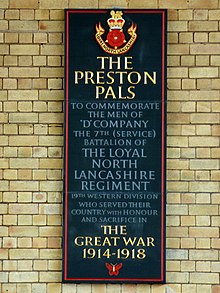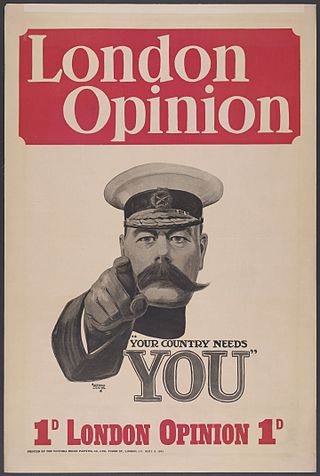
At the beginning of 1914 the British Army had a reported strength of 710,000 men including reserves, of which around 80,000 were professional soldiers ready for war. By the end of the First World War almost 25 percent of the total male population of the United Kingdom of Great Britain and Ireland had joined up, over five million men. Of these, 2.67 million joined as volunteers and 2.77 million as conscripts. Monthly recruiting rates for the army varied dramatically.

The 31st Division was an infantry division of the British Army. It was raised in the Great War by volunteers from Kitchener's Army and formed in April 1915 as part of the K4 Army Group and taken over by the War Office on 10 August 1915. Comprising mainly infantry battalions from Yorkshire and Lancashire, the division was sent to Egypt in December 1915 before moving to France in March 1916 and spent the remainder of the First World War in action on the Western Front. The 31st Division was the quintessential New Army division, being made up entirely of Pals battalions.
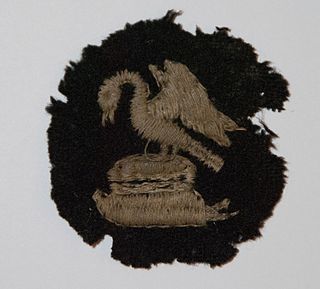
The British 30th Division was a New Army division that was originally made up of battalions raised by public subscription or private patronage. The division was taken over by the British War Office in August 1915 and moved to France in December. It served on the Western Front for the duration of the First World War.

The Accrington Pals, officially the 11th (Service) Battalion (Accrington), East Lancashire Regiment, was a pals battalion of Kitchener's Army raised in and around the town of Accrington during the First World War.
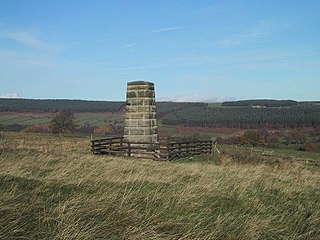
The Leeds Pals were a First World War Pals battalion of Kitchener's Army raised in the West Yorkshire city of Leeds. When the battalion was taken over by the British Army it was officially named the 15th Battalion, The Prince of Wales's Own.

The Royal Munster Fusiliers was a regular infantry regiment of the British Army. One of eight Irish regiments raised largely in Ireland, its home depot in Tralee. With the outbreak of World War I in August 1914 the immediate need for a considerable expansion of the British Army resulted in the formation of the New Army under Lord Kitchener. The war target was seventy divisions in all, the New Army to have thirty volunteer divisions separate and under Army Order 324, as additional from the Regular Army, with a planned period of service of at least three years. On 7 August a general United Kingdom-wide call for 100,000 volunteers aged 19–30 was issued. The battalions were to be distinguished by the word 'Service' after their number.
The Sheffield City Battalion was a 'Pals battalion' formed as part of 'Kitchener's Army' during World War I. Raised by local initiative in the City of Sheffield, it became the 12th (Service) Battalion of the local York and Lancaster Regiment. After almost two years of training, it was virtually destroyed on the first day of the Battle of the Somme in a disastrous attack on the village of Serre. The battalion continued to serve on the Western Front, including the Arras offensive, but it was disbanded early in 1918.

The Barnsley Pals were two 'Pals battalions' formed as part of 'Kitchener's Army' during World War I. Raised by local initiative in the town of Barnsley in the West Riding of Yorkshire and recruited largely from coalminers, they became the 13th and 14th (Service) Battalions of the local York and Lancaster Regiment. After almost two years of training, the battalions suffered heavy casualties in a disastrous attack on the village of Serre on the first day of the Battle of the Somme. They continued to serve on the Western Front, including the Battle of Arras (1917). Combined into a single battalion in early in 1918, the Barnsley Pals were reduced to a remnant during the German spring offensive, but the battalion was rebuilt to participate in the final victorious Hundred Days Offensive.
The 94th Brigade was an infantry formation of the British Army during World War I. It was raised as part of 'Kitchener's Army' and was assigned to the 31st Division. After the original formation was converted into a reserve brigade, the number was transferred to a brigade of 'Pals battalions' from Northern England. It was sent to Egypt at the end of 1915 but was recalled to France shortly afterwards and then served on the Western Front for the rest of the war. The brigade was shattered on the First day on the Somme, but later saw action at Arras and distinguished itself at the Capture of Oppy Wood. It was temporarily disbanded in early 1918 but was reconstituted from dismounted Yeomanry regiments in time to take part in the final battles of the war.

The Liverpool Pals were Pals battalions formed during the First World War as part of the King's (Liverpool) Regiment. They, along with the Manchester Pals, are commemorated at a small memorial in France.

During World War I (1914–1918), Ireland was part of the United Kingdom of Great Britain and Ireland, which entered the war in August 1914 as one of the Entente Powers, along with France and Russia. In part as an effect of chain ganging, the UK decided due to geopolitical power issues to declare war on the Central Powers, consisting of Germany, Austria-Hungary, the Ottoman Empire, and Bulgaria.
The Sportsman's Battalions, also known as the 23rd (Service) Battalion and 24th (Service) Battalion, Royal Fusiliers were among the Pals battalions formed by the British Army in the early stages of the First World War (1914–1918). Rather than be taken from a small geographical area, these particular battalions were largely made up of men who had made their name in sports such as cricket, golf, boxing and football or the media. It was intended for upper and middle class men, physically fit, able to shoot and ride, up to the age of 45.
The Preston Pals — officially 'D' Company, 7th (Service) Battalion, Loyal North Lancashire Regiment — were a group of men from the town of Preston in Lancashire, England, who volunteered to fight in France during World War I, and took part in the Battle of the Somme.
The 91st Brigade was an infantry formation of the British Army during World War I. It was raised as part of 'Kitchener's Army' and was assigned to the 30th Division. After the original formation was converted into a reserve brigade, the number was transferred to a brigade of 'Manchester Pals'. The brigade landed in France at the end of 1915 and was transferred to the Regular 7th Division. It saw action at the Somme, Arras, and Ypres before being sent to the Italian Front, where it took part in the final Battle of Vittorio Veneto. The brigade's number was briefly revived during the 1950s.
The 92nd Brigade was an infantry formation of the British Army during World War I. It was raised as part of 'Kitchener's Army' and was assigned to the 31st Division. After the original formation was converted into a reserve brigade, the number was transferred to a brigade composed volunteer battalions raised in the city of Kingston upon Hull for 'Kitchener's Army'. It first served in Egypt defending the Suez Canal between January and March 1916. It then left for the Western Front where it was at Serre on the first day of the Battle of the Somme in 1916, though its battalions escaped the worst of the disaster. It continued to serve on the Western Front for the rest of the war, including hard fighting at Oppy Wood, against the German spring offensive and in the final Hundred Days Offensive.
The 99th Brigade was a formation of the British Army during the First World War. It was raised as part of the new army also known as Kitchener's Army and assigned to the 33rd Division. The brigade served on the Western Front. In November 1915, the brigade was transferred to the 2nd Division.
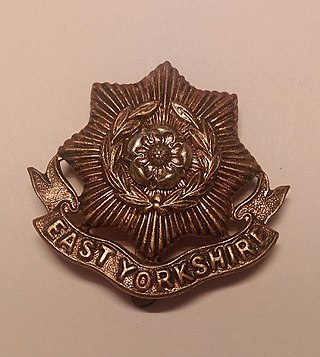
The Hull Pals were a brigade of four battalions of the East Yorkshire Regiment raised as part of Kitchener's Army in 1914. They served in 31st Division at Serre on the first day of the Battle of the Somme in 1916, though they escaped the worst of the disaster. However, they suffered heavy casualties in the same area later in the year, and again at Oppy Wood in early 1917. They continued to serve on the Western Front for the rest of the war, including hard fighting against the German spring offensive and in the final Hundred Days Offensive.

Reginald St John Beardsworth Battersby was, at the age of 15, the youngest known commissioned officer of the British Army of the First World War. He enlisted in the Manchester Regiment at the age of 14 and was promoted to lance corporal within a week. When his father realised what Battersby had done, he intervened and had him commissioned as an officer in the East Lancashire Regiment. Battersby was wounded in action leading a platoon over the top on the first day of the Somme but returned to duty to fight in the 1917 Operations on the Ancre. There, he was struck by shrapnel from a German shell, resulting in the amputation of his left leg. Battersby was asked to resign his commission owing to disability. He insisted he could still be useful to the army if fitted with a prosthetic leg and successfully returned to duty with a Royal Engineers transport unit. After the war, he studied theology and became a vicar at Chittoe, Wiltshire. During the Second World War, he organised the local Home Guard unit and, between 1943 and 1945, served as a chaplain to the Royal Marines at Chatham Dockyard.


